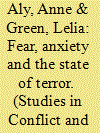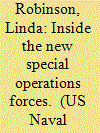| Srl | Item |
| 1 |
ID:
094848


|
|
|
|
|
| Publication |
2010.
|
| Summary/Abstract |
The 11 September 2001 terrorist attacks on the World Trade Center and the Pentagon marked the advent of an unprecedented preoccupation with terrorism. Although Australia's actual terrorist risk profile remains marginal in comparison with other mortality risks, in times of crisis, the reasoned negotiation of risk is marginalised. Drawing on the findings of qualitative research, this article offers an analysis of how Australians are responding to the threat of terrorism embodied in a developing discourse of the war on terror and how they construct their perceptions of terrorist risk. The findings implicate community fear as a factor that should be considered in the development of counter terrorism strategies that emphasize community engagement as a mechanism for challenging radicalisation in democratic states.
|
|
|
|
|
|
|
|
|
|
|
|
|
|
|
|
| 2 |
ID:
096455


|
|
|
| 3 |
ID:
107470


|
|
|
|
|
| Publication |
2011.
|
| Summary/Abstract |
Following the terrorist attacks in 2001, much time and effort has been put toward improving catastrophic incident response. But recovery-the period following initial response that focuses on the long-term viability of the affected area-has received less attention. Recognizing the importance of being able to recover an area following a catastrophic incident, the Department of Defense, through its Defense Threat Reduction Agency (DTRA), and the Department of Homeland Security, through its Science and Technology Directorate (DHS S&T), created the Interagency Biological Restoration Demonstration (IBRD) program. IBRD was a 4-year program jointly managed and funded by DTRA and DHS S&T, the goal of which was to reduce the time and resources necessary to recover a wide urban area from an intentional release of Bacillus anthracis. Specific program objectives included understanding the social, economic, and operational interdependencies that affect recovery; establishing long-term coordination between the Departments of Defense and Homeland Security; developing strategic recovery/restoration plans; identifying and demonstrating technologies that support recovery; and exercising recovery activities and technology solutions. IBRD has made important first steps toward improving national preparedness in the area biological incident recovery. Specifically, IBRD has helped enhance the efficacy and efficiency of recovering large urban areas by developing consequence management guidance; identifying key S&T capabilities and integrating them with planning and guidance documents; and establishing key relationships across the federal interagency, federal-to-regional, civilian-to-military, and public-to-private stakeholders. Upon completion of IBRD in fall 2010, both DTRA and DHS S&T planned follow-on programs.
|
|
|
|
|
|
|
|
|
|
|
|
|
|
|
|